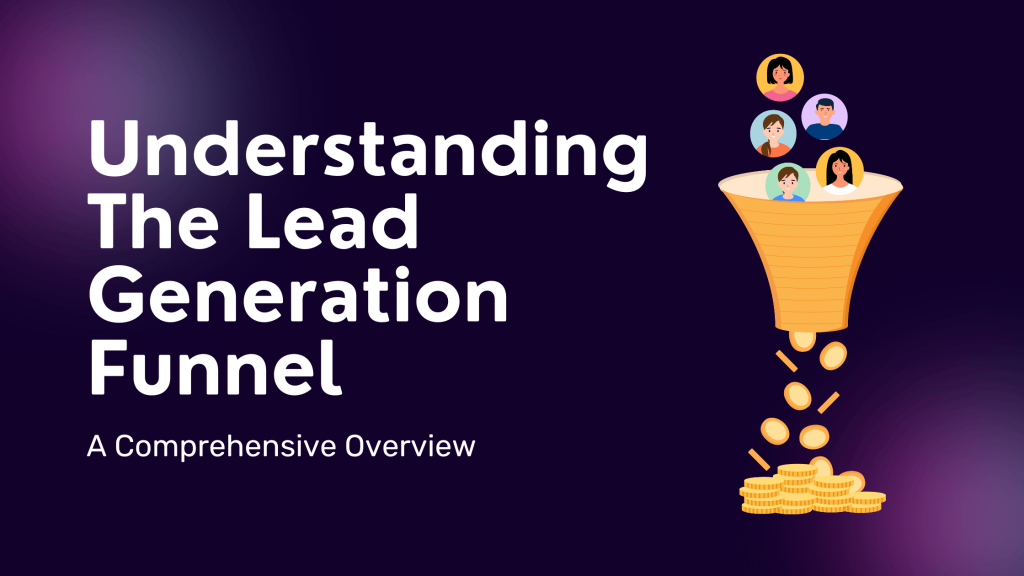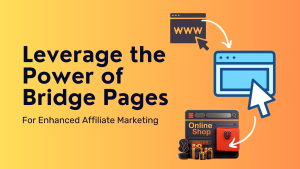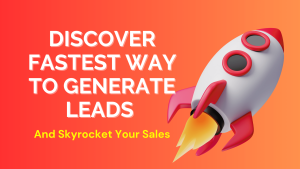A lead generation funnel is the process that you take a lead through. You do this in order to turn them into a customer. The process usually starts with acquiring leads, and then optimizing their experience through the funnel until they become a customer.
In this article, we’ll take a detailed look at lead generation funnels. We’ll start by understanding what they are, and then explore each stage of the funnel in detail. Next, we’ll look at some funnel optimization techniques, and finally discuss some key metrics for success.
Table Of Content.
- What is a Lead Generation Funnel?
- The Lead Funnel Stages
- Optimizing Your Lead Funnel
- Lead Funnel Metrics
- Lead Funnel Automation
What is a Lead Generation Funnel?
A lead generation funnel is a strategic process that modern businesses use to attract and convert potential customers into leads and ultimately, paying customers.
It is a visual representation of the customer journey, guiding individuals through different stages until they are ready to make a purchase.
Here Are Different Types of Lead Funnels:
There are various types of lead funnels, each customized to specific marketing goals and target audiences. Some commonly used types include:
1. Traditional Funnel: This is the most common type of lead funnel which follows a linear progression from awareness to conversion.
2. Reverse Funnel: In this type, the leads are acquired first and then filtered down to the most interested and qualified prospects.
3. Multi-Channel Funnel: This type utilizes different marketing channels such as websites, social media, and email marketing to engage and convert leads.
💡 Key Takeaway: Lead generation funnels are systematic processes that guide prospects towards making purchasing decisions. Different types of lead funnels, such as the traditional sales funnel and reverse funnel, offer businesses flexibility in attracting and converting leads.
The Lead Funnel Stages
When it comes to lead generation, understanding the stages of the lead funnel is crucial for success.
Every stage represents a different level of engagement and intent from your potential customers.
By strategically targeting and nurturing leads at each stage, you can guide them towards conversion and maximize your chances of turning them into loyal customers.
Stage 1. Awareness
Awareness is the first stage of the lead generation funnel where potential customers become aware of your brand, products, or services.
It’s crucial to capture their attention and stand out from the competition.
Here are some key strategies to enhance awareness in your lead funnel:
1. Crafting Compelling Content: Create informative and engaging content that addresses your target audience’s pain points and offers valuable solutions.
Use blog posts, articles, videos, infographics, and social media posts to spread brand awareness.
2. Search Engine Optimization (SEO): Optimize your content with relevant keywords, meta tags, and descriptions to improve search engine rankings.
This helps potential customers discover your brand when searching for related topics in search engines.
3. Guest Blogging and Influencer Partnerships: Collaborating with industry influencers and guest blogging on reputable websites can expand your reach and expose your brand to a wider audience.
Just Make sure the platforms align with your target demographics.
4. Social Media Marketing: Leverage popular social media platforms to share valuable content, interact with your audience, and build a community around your brand.
Utilize hashtags, compelling visuals, and encourage shares to increase visibility.
5. Online Advertising: Invest in paid advertising methods such as Google Ads, social media ads, and display ads to target specific demographics and reach a broader audience.
Use compelling ad copy and eye-catching visuals to capture attention.
💡 key Takeaway: Creating awareness is the first crucial step in the lead generation funnel. Implementing strategies like crafting compelling content, optimizing for search engines, collaborating with influencers, utilizing social media, and investing in online advertising can help expand your brand’s reach and attract potential customers.
Stage 2. Interest / Consideration
In the interest/consideration stage of the lead generation funnel, the potential customer is showing a deeper level of interest in the products or services offered.
This is the phase where they are actively considering different options and evaluating the value of your offering.
To effectively engage your audience in this stage, here are some key strategies to implement:
1. Engaging Content: Create informative and compelling content that addresses the pain points and challenges your target audience may face. This can be achieved through blog articles, case studies, whitepapers, and informative videos.
2. Educate and Inform: Provide valuable insights and information that help potential customers evaluate the benefits of your product or service. Showcase your expertise by highlighting unique selling points, success stories, and industry trends.
3. Comparison Guides: Comparison guides can be immensely helpful in the consideration stage. Provide a detailed, unbiased comparison of your offerings with competitors, highlighting the unique features and benefits your solution brings to the table.
4. Social Proof: Incorporate testimonials, reviews, and case studies that demonstrate your ability to deliver results. Leverage social proof to build trust and credibility in your brand.
5. Interactive Tools: Implement interactive tools such as quizzes, calculators, or product configurators to engage your audience and provide personalized experiences. These tools can help potential customers evaluate their specific needs and see the value of your offering.
6. Clear Calls-to-Action: Include clear and compelling calls-to-action that guide your audience towards the next step of the funnel. Whether it’s signing up for a demo, requesting a personalized quote, or downloading a resource, make it easy for them to take the next action.
💡 key Takeaway: In the interest/consideration stage of the lead generation funnel, it is crucial to provide informative and engaging content that educates potential customers about your offering. Incorporate social proof, comparison guides, interactive tools, and clear calls-to-action to effectively convince and convert your audience during this stage.
Stage 3. Decision / Conversion
In the decision/conversion stage of the lead generation funnel, prospects have transitioned from the interest/consideration stage and are now ready to make a decision or take a desired action.
This stage is critical as it can determine whether a prospect becomes a qualified lead or drops out of the funnel.
Here are some key strategies and tactics to optimize this stage:
1. Compelling Calls-to-Action (CTAs): Utilize persuasive and action-oriented CTAs that clearly communicate the benefits and value of taking the desired action.
Whether it’s downloading an e-book, subscribing to a newsletter, or making a purchase, the CTA should be visually appealing, easily clickable, and placed strategically on the website or landing page.
2. Streamlined Conversion Process: Make sure the conversion process is seamless and user-friendly. Keep it simple by minimizing the number of form fields and reducing any unnecessary steps.
The goal is to make it easy for prospects to convert without any friction or obstacles that could potentially lead to drop-offs.
3. Social Proof: Incorporate social proof elements such as testimonials, case studies, and reviews to build credibility and trust with prospects.
Highlight success stories and demonstrate the positive experiences others have had with your product or service during the decision-making process.
4. Personalization: Tailor the messaging and content to address the specific needs, pain points, and objections of your prospects.
Use data and insights you’ve gathered throughout the funnel to personalize the experience and make prospects feel understood and valued.
5. Remarketing and Email Campaigns: Implement effective remarketing strategies to target prospects who have shown interest but haven’t converted yet.
Set up personalized email campaigns that send timely and relevant messages to nudge-worthy prospects towards the desired action.
💡 key Takeaway: The decision/conversion stage is where prospects are ready to take action. By utilizing compelling CTAs, streamlining the conversion process, incorporating social proof, personalizing the experience, and implementing remarketing strategies, you can increase the likelihood of conversions and successfully guide prospects through the lead generation funnel.
Optimizing Your Lead Funnel
To maximize the effectiveness of your lead generation funnel, it’s crucial to optimize each stage. By tailoring your content and analyzing key metrics, you can boost conversions and improve your overall success rate. Here are some strategies to consider:
Optimize Content for Each Stage
Optimizing your content for each stage of the lead generation funnel is crucial for maximizing conversions and driving results.
Here are some key strategies to consider:
1. Tailor your content to the awareness stage: At this stage, prospects are just becoming aware of their pain points and exploring potential solutions.
Your content should focus on educating and building trust.
Use informative blog posts, ebooks, and infographics to provide valuable insights and establish yourself as an industry authority.
2. Create engaging content for the interest/consideration stage: As prospects move deeper into the funnel, they are actively researching and comparing different options.
Develop content that showcases the unique value of your product or service.
Consider creating case studies, comparison guides, and webinars that highlight the benefits and features that set you apart.
3. Provide compelling content for the decision/conversion stage: At this final stage, prospects are ready to make a purchasing decision.
Your content should emphasize the benefits of your solution and address any remaining objections.
Offer product demos, free trials, and customer testimonials to alleviate concerns and solidify their decision to choose your offering.
4. Use personalization: Customize your content to the specific needs and preferences of your target audience. Use data-driven insights to deliver personalized messages at each stage of the funnel.
Personalization not only increases engagement but also helps build stronger connections with your prospects.
5. Incorporate strong calls-to-action: Guide your prospects through the funnel with clear and compelling calls-to-action (CTAs).
Use action-oriented language and strategically place CTAs to encourage conversions. Make sure they are relevant to each stage and provide a clear benefit to the user.
6. Optimize for mobile: With the increasing prevalence of mobile usage, it is essential to ensure your content is mobile-friendly.
Optimize your website and landing pages for all devices including mobile phones, as this can significantly increase your conversion rates.
💡 key Takeaway: Optimizing your content for each stage of the lead generation funnel is crucial for driving conversions. Tailor your content to the awareness, interest/consideration, and decision/conversion stages to provide value and guide prospects through the buying journey.
Analyzing Metrics at Each Stage
Measuring and analyzing metrics at each stage of the lead generation funnel is crucial for optimizing the effectiveness of your efforts.
By closely monitoring key metrics, you can identify strengths and weaknesses in your funnel and make data-driven decisions to improve your results.
1. Awareness Stage:
– Traffic Volume: Keep an eye on the number of visitors your website or landing page attracts during this stage. This metric will indicate the reach of your awareness campaigns.
– Pageviews: Measure how many pages within your website or landing page are viewed by visitors. This metric can show the level of engagement and interest generated.
– Unique Visitors: This metric helps you understand the number of distinct individuals who visit your site, providing insights into the size of your potential audience.
2. Interest / Consideration Stage:
– Time on Page: Analyze how long visitors spend on your page during this stage. The longer the duration, the more engaged they are with your content.
– Bounce Rate: This metric reveals the percentage of visitors who navigate away from your site after viewing only one page. A high bounce rate may indicate a lack of relevance or poor user experience.
– Click-through Rate (CTR): Measure the number of clicks on call-to-action buttons or links on your page. A higher CTR suggests that visitors are interested in exploring your offering further.
3. Decision / Conversion Stage:
– Conversion Rate: Evaluate the proportion of visitors who complete the desired action, such as filling out a form or making a purchase. This metric directly reflects your funnel’s effectiveness in converting leads.
– Cost per Acquisition (CPA): Calculate the average cost of acquiring a lead at this stage. Understanding your CPA allows you to assess your marketing spend and optimize your budget allocation.
Remember, these metrics provide valuable insights into your lead generation funnel’s performance. Use analytical tools like Google Analytics or CRM systems to track and interpret the data. Continuously measure, analyze, and refine your approach to improve your conversions and maximize the ROI of your lead generation efforts.
💡 key Takeaway: Analyzing metrics at each stage of the lead generation funnel is crucial for optimizing campaign performance. Tracking key metrics such as traffic volume, bounce rate, and conversion rate helps identify areas for improvement and refine your lead generation process. By making data-driven decisions and continuously monitoring performance, you can enhance the effectiveness of your lead funnel and drive better results.
Lead Funnel Metrics
When it comes to measuring the success of your lead generation funnel, there are several key metrics that you should pay attention to.
These metrics will give you insights into the effectiveness of each stage of your funnel and help you optimize your efforts for better results.
Here are some important lead funnel metrics to track:
1. Lead Quality: One of the most crucial metrics to consider is the quality of leads generated. It’s not just about the quantity of leads, but also about the quality.
Look at factors such as lead source, demographics, and behavior to determine if the leads are a good fit for your business. High-quality leads have a higher chance of converting into customers.
2. Conversion Rate: The conversion rate measures the percentage of leads that successfully move through each stage of the funnel and eventually become customers.
Tracking the conversion rates at each stage will give you an idea of where the bottlenecks or drop-offs are happening. This information will help you identify areas that need improvement or optimization.
3. Cost per Acquisition: Another important metric to track is the cost per acquisition (CPA), which calculates how much it costs to acquire a customer.
This metric takes into account all the marketing and sales expenses associated with acquiring a customer. Keeping your CPA low while maintaining or increasing lead quality is essential for a profitable lead funnel.
By analyzing these metrics, you can gain valuable insights into the performance of your lead generation funnel and make data-driven decisions to optimize your efforts. This will help you focus your resources on the areas that yield the best results and ensure a higher return on investment (ROI).
“Measuring lead funnel metrics is essential for optimizing your lead generation efforts and maximizing your ROI.”
Lead Quality
Ensuring the quality of leads is crucial for the success of your lead generation funnel. After all, the ultimate goal is to convert those leads into customers. Here are some key considerations when it comes to lead quality:
1. Targeted Audience: It’s important to attract leads who are genuinely interested in your product or service. By defining your target audience and creating tailored content, you can attract leads who are more likely to convert.
2. Lead Source: Different lead sources can vary in terms of quality. For example, leads generated through organic search or referral traffic may have a higher conversion rate compared to leads from paid advertisements. Continuously analyze and optimize your lead sources to focus on the ones that provide high-quality leads.
3. Lead Profiling: Developing lead profiles can help you understand the characteristics of your ideal customers. By collecting data such as demographics, behaviors, and preferences, you can better identify leads with a higher potential for conversion.
4. Lead Scoring: Implementing a lead scoring system can help you prioritize leads based on their level of engagement and readiness to purchase. Assigning scores to leads allows you to focus your efforts on those with the highest potential for conversion, optimizing your time and resources.
5. Continuous Evaluation: Regularly reviewing lead data and performance metrics can provide valuable insights into the quality of your leads. Identify patterns or trends that indicate higher or lower conversion rates and adjust your lead generation strategies accordingly.
💡 key Takeaway: Prioritizing lead quality is essential for the success of your lead generation funnel. By attracting targeted leads, optimizing lead sources, developing lead profiles, implementing lead scoring, and continuously evaluating performance, you can increase the chances of converting leads into customers.
Conversion Rate
The conversion rate is a vital metric in evaluating the effectiveness of your lead generation funnel. It measures the percentage of leads that successfully complete the desired action, such as making a purchase or filling out a form. By tracking and analyzing this metric, you can gain insights into the performance of your funnel at the Decision/Conversion stage.
Here are some key points to consider when optimizing your conversion rate:
1. Clear Call-to-Action: Ensure that your call-to-action (CTA) is clear, persuasive, and easily visible. Use action-oriented language and compelling visuals to prompt users to take the desired action.
2. Streamlined Conversion Process: Simplify the conversion process by minimizing the number of form fields or steps required. A lengthy or complex conversion process can lead to friction and cause potential leads to drop off.
3. Trust Signals: Build trust with your audience by including trust signals, such as customer testimonials, reviews, security badges, or industry certifications. These elements help establish credibility, which can increase the likelihood of conversions.
4. A/B Testing: Conduct A/B tests to optimize your conversion rate. Test different variations of your landing page, CTA copy, design elements, or form layout to identify the most effective combination for driving conversions.
5. Personalization and Segmentation: Tailor your messaging and offers to specific segments of your audience. Personalized content can significantly increase conversion rates by addressing the unique needs and interests of different prospects.
Quote: “Conversion rate optimization is an ongoing process that requires continuous testing, tracking, and tweaking to maximize the effectiveness of your lead generation funnel.” – (Anonymous)
💡 key Takeaway: The conversion rate is a critical metric in measuring the performance of your lead generation funnel. To optimize it, focus on a clear call-to-action, streamline the conversion process, build trust with trust signals, conduct A/B testing, and personalize your messaging.
Cost per Acquisition
Cost per Acquisition (CPA) is a key metric in lead generation funnels that measures the total cost incurred to acquire a single lead or customer. It is calculated by dividing the total cost of marketing campaigns and sales efforts by the number of acquisitions generated within a specified period.
Understanding the CPA allows businesses to gauge the effectiveness and efficiency of their lead generation efforts. By analyzing this metric, companies can evaluate the return on investment (ROI) of their marketing and sales activities, ensuring that they are acquiring leads at a cost that is economically viable for the organization.
Optimizing the CPA requires a multi-faceted approach. Here are some strategies to consider:
1. Targeted Audience Segmentation: Identify specific audience segments that are more likely to convert at a lower cost. By tailoring marketing efforts to these segments, you can optimize your CPA.
2. Landing Page Optimization: Invest time and resources in optimizing landing pages to increase conversion rates. A well-designed, clear, and compelling landing page can improve the overall performance of your lead generation funnel and reduce CPA.
3. Ad Campaign Performance: Continuously monitor your ad campaigns to identify any campaign that might be underperforming or driving up costs unnecessarily. Regularly update and refine your targeting, messaging, and bidding strategies to improve your ads’ performance and lower CPA.
4. Lead Nurturing: Implement effective lead nurturing strategies to build relationships with leads and guide them through the conversion process. By providing valuable content and personalized experiences, you can increase the likelihood of conversions while minimizing CPA.
Remember, while lowering CPA is important, it should not compromise lead quality. It’s crucial to strike a balance between cost and the quality of leads acquired. Analyzing metrics, such as lead quality and conversion rates, alongside CPA, can help you ensure that your lead generation efforts are yielding both quantity and quality leads.
💡 key Takeaway: Cost per Acquisition (CPA) is a vital metric in lead generation funnels that measures the cost to acquire a single lead or customer. Optimizing CPA involves targeted audience segmentation, landing page optimization, monitoring ad campaign performance, and implementing effective lead nurturing strategies. Balancing CPA with lead quality is crucial for successful lead generation.
Lead Funnel Automation
Automating lead nurturing and lead scoring processes can greatly enhance the efficiency and effectiveness of your lead generation funnel. By leveraging technology and data-driven strategies, companies can streamline the lead nurturing process, allowing them to focus on highly qualified leads and improve conversion rates.
1. Automate Lead Nurturing:
Automated lead nurturing involves delivering targeted and personalized content to prospects at each stage of the funnel. This can be achieved through email marketing campaigns, where specific messages are triggered based on user behavior or stage in the customer journey. By automating this process, you ensure that the right content reaches the right people at the right time, increasing engagement and nurturing relationships.
“Marketing automation allows businesses to provide relevant and timely information to prospects, nurturing them towards conversion.”
2. Automate Lead Scoring:
Lead scoring is a system used to rank leads based on their likelihood to convert into paying customers. By automating lead scoring, you can save time and effort by allowing technology to analyze prospect behavior, demographics, and engagement. This helps prioritize high-value leads and sales-ready prospects, allowing your sales team to focus their efforts on the most promising opportunities.
“Automated lead scoring ensures that your sales team spends time on leads that have the highest potential to convert, leading to increased efficiency and improved conversion rates.”
💡 key Takeaway: Automating lead nurturing and lead scoring processes can significantly improve the efficiency and effectiveness of your lead generation funnel, allowing you to focus on high-quality leads and increase conversion rates.
Automate Lead Nurturing
Automate Lead Nurturing
Lead nurturing plays a crucial role in the success of your lead generation funnel. It involves building relationships with potential customers at every stage of the funnel to guide them towards a purchase decision. However, manually nurturing leads can be time-consuming and inefficient. That’s where lead nurturing automation comes into play.
1. Why Automate Lead Nurturing?
Automating lead nurturing allows you to deliver targeted and personalized content to your leads, based on their behavior and interests. This ensures that each lead receives the right information at the right time, increasing the chances of conversion.
2. Benefits of Lead Nurturing Automation
– Saves Time: With automated lead nurturing, you can set up a series of pre-defined emails or messages that are triggered based on specific actions or time intervals. This eliminates the need for manual follow-ups and saves time for your sales and marketing teams.
– Personalization: Automation tools allow you to segment your leads based on various criteria such as demographics, behavior, interests, etc. This enables you to send personalized content that resonates with each individual lead, increasing engagement and conversion rates.
– Consistency: Automated lead nurturing ensures that every lead receives consistent and timely communication, regardless of the size of your contact list. This helps in building trust and keeping your brand top of mind for potential customers.
3. Best Practices for Automated Lead Nurturing
– Segment Your Leads: Divide your leads into different segments based on their characteristics and behavior. This helps you deliver targeted and relevant content that addresses their specific pain points or needs.
– Personalize Your Messages: Craft personalized messages that speak directly to the needs and interests of your leads. Use their names, refer to their previous interactions, and align the content with their stage in the lead funnel.
– Leverage Multiple Channels: Don’t limit your automated lead nurturing efforts to just email. Explore other channels such as social media, SMS, or even personalized landing pages to engage with your leads effectively.
4. Case Study: Company X Improves Conversion Rates with Automated Lead Nurturing
“By implementing an automated lead nurturing strategy, Company X witnessed a 30% increase in lead-to-customer conversion rates. The targeted and personalized content delivered to leads at different stages of the funnel resulted in better engagement and faster decision-making.”
💡 key Takeaway: Automating lead nurturing in your lead generation funnel streamlines the process, saves time, and provides personalized interactions for your potential customers. By implementing best practices and leveraging automation tools,
Automate Lead Scoring
Automating lead scoring in your lead generation funnel can greatly enhance your efficiency and effectiveness in identifying high-quality leads. Lead scoring allows you to prioritize and focus on leads that are most likely to convert into paying customers. By leveraging automation tools and technologies, you can streamline the lead scoring process and save valuable time.
1. Understanding Lead Scoring:
Lead scoring is a method used to assign a numerical value or score to potential leads based on their behavior, demographics, and engagement with your brand. This helps you determine which leads are most likely to take the desired conversion action. Automation can simplify this process by automatically assigning scores to leads based on predefined criteria.
2. Setting Up Automated Lead Scoring:
To automate lead scoring, you need a well-defined scoring system. Start by identifying the key attributes and behaviors that indicate a lead’s interest and readiness to convert. Assign points to each criterion based on its importance and relevance. Then, leverage marketing automation platforms or customer relationship management (CRM) systems to set up automated workflows that assign scores to leads based on their interactions and attributes.
3. Incorporating Behavioral Tracking:
Behavioral tracking is an essential component of automated lead scoring. By monitoring a lead’s actions on your website, such as page visits, content downloads, and form submissions, you can gather valuable data to determine their level of interest and engagement. Automation tools can track these behaviors and update lead scores accordingly.
4. Adjusting Lead Scores:
As leads progress through your lead generation funnel, their scores may need adjustments. By setting up automation rules, you can automatically increase or decrease a lead’s score based on specific milestones or actions they take. For example, if a lead requests a demo or subscribes to your newsletter, their score may increase, indicating a higher level of interest.
5. Integrating with CRM:
Automated lead scoring should integrate seamlessly with your CRM system to ensure a smooth handoff between marketing and sales teams. When a lead’s score reaches a certain threshold, it can trigger alerts or notifications for the sales team to follow up. This ensures that high-value leads are not missed or neglected during the handover process.
💡 key Takeaway: Automating lead scoring in your lead generation funnel can save time, increase efficiency, and help you focus on high-quality leads. By setting up automated workflows, incorporating behavioral tracking, and integrating with CRM systems, you can effectively identify and prioritize leads most likely to convert.
Conclusion
Conclusion A lead generation funnel is a marketing tool used to generate leads. It is a process that begins with acquiring potential customers and ends with converting them into paying customers. Lead generation funnel stages include acquisition, conversion, and activation. Acquisition is the process of acquiring potential customers.
This can include things like online advertising, content marketing, and lead generation forms. Conversion is the stage where potential customers are converted into paying customers. This can involve things like providing quality service, providing a great product, and making the sale. Activation is the stage where potential customers become customers and start spending money. This can involve things like providing great customer service, following up with customers, and providing value. Lead generation funnels are important because they help businesses generate leads in a more efficient and effective way. By understanding the various stages and optimization techniques, you can improve your lead generation process and achieve your business goals.






